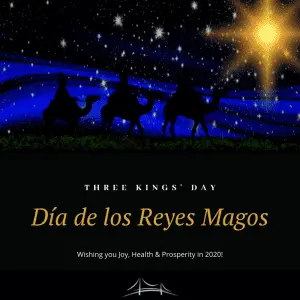What comes to mind when we think about “Holiday Traditions” in the U.S.? Typically, the season starts with Thanksgiving and goes through Christmas, and involves lots of shopping, parties, gatherings with family and friends, and for many, attending a special church service or mass. And of course, don’t forget the New Year’s Eve festivities to end the season!
For Hispanics throughout the world as well as in the U.S., the holiday season includes all of these things, and more. Nochebuena (“Good Night,” or Christmas Eve) is the preferred time for gift-giving, while Christmas Day is more relaxed with a focus on the birth of Jesus.
Of course, ushering in the New Year on Nochevieja (“Old Night,” or New Year’s Eve) with family and friends is important, too. But for the majority of Latinos, the celebrations don’t end there, as anticipation builds for “Día de los Reyes Magos” (Three Kings’ Day) on January 6th.
Also known as Epiphany, Three Kings’ Day for Catholics, and particularly Hispanics, celebrates the arrival in Bethlehem of the Three Wise Men bearing gifts for the baby Jesus. It is said that they followed a star for 12 days across the desert, beginning on December 25th and arriving on January 6th – the true period of The 12 Days of Christmas.
For Hispanics, Three Kings’ Day is the culmination of the holiday season, the day when additional gifts are exchanged and big family celebrations take place. Children write letters in advance to the Three Kings, telling them how good they were during the year and asking for gifts. On the Night of Kings (January 5th), children place their shoes outside their bedrooms so that the Three Kings will leave presents in them.
Some may also leave a treat for the Kings, and grass and water for the camels. In some Spanish-speaking countries, there are parades on the streets recreating and celebrating the arrival of the Three Kings. In others, people get together for the Bajada de Reyes (Taking Down of the Kings) by dismantling their Nativity scenes as part of the celebrations.
For Hispanic children, Día de los Reyes Magos is exciting! They get up early to find the gifts the Three Kings brought them. Families gather around and share a typical dish called Rosca de Reyes (King’s Cake), a round, sweet bread resembling the crown of a king, decorated with dried fruits and nuts symbolizing the Kings’ jewels.
Hidden inside the dough is a figurine of the baby Jesus, and according to the tradition, whoever finds it will be blessed during the year and will host the upcoming celebration of Candlemas Day on February 2nd. (Have you noticed the theme of families, friends, and fiestas?)
Three Kings’ Day wraps up the holiday season for Latinos, with loved ones together sharing not only food, gifts, joy and laughter, but a beautiful tradition that resonates all year long.


